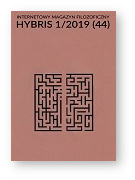SPOSÓB POSTRZEGANIA PRZESZŁOŚCI JAKO ŚWIATŁO DLA μελέτη θανάτου. PRZYCZYNEK Z ODNIESIENIEM DO MYŚLI PARMENIDESA Z ELEI (B3)
A way of looking at the past as a light for μελέτη θανάτου. A sketch with reference to the thought of Parmenides of Elea (B3)
Author(s): Mieszko WandowiczSubject(s): History of Philosophy, Philosophical Traditions, Special Branches of Philosophy
Published by: Wydawnictwo Uniwersytetu Łódzkiego
Keywords: past; death; existence; μελέτη θανάτου; ἄσκησις
Summary/Abstract: The aim of my article is to present some reflections on the connection between the way of existence of the past (as we are entitled to see it) and our approach to dying and death. The basis of my reflections is a certain view of Plato’s words „μελέτη θανάτου” (Phaedo, 81 a) in combination with Parmenidean „τὸ γὰρ αὐτὸ νοεῖν ἐστίν τε καὶ εἶναι” (Περί φύσεως, B3), which seems to be permissible and intelectually beneficial result of looking at these parts of their works in the light of ἄσκησις: philosophy understood as an art of wise living and dying. One of the most important messages of ancient philosophy is probably the notion that what can be thought, has to exist. If so—as thinking (remembering) about the past is more reliable than about the future— the past and the future must have different ontic status. Considering, e.g., C. D. Broad’s growing universe theory, it may be acceptable to recognize someone’s death as another layer of his existence, which does not destroy the previous layers. It allows to change a view of, firstly, future or actual absence of deceased person, secondly — inevitable coming of (to) death.
Journal: Internetowy Magazyn Filozoficzny HYBRIS
- Issue Year: 2018
- Issue No: 44
- Page Range: 117-130
- Page Count: 14
- Language: Polish

